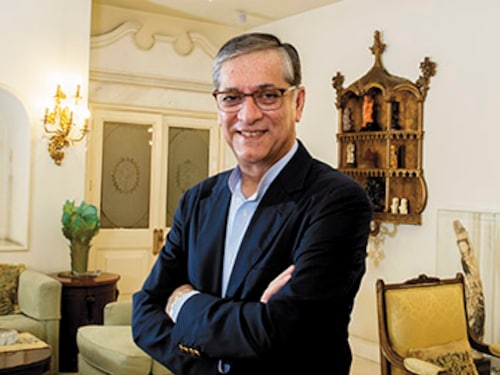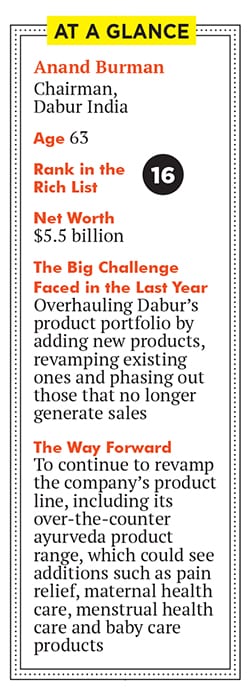Anand Burman scripting a 'future-ready' makeover
When he is not attending to his personal investments in health care ventures, Anand Burman is driving changes at Dabur India so that the 130-year-old firm does not wither with age


“The question of regret does not arise,” says the 63-year-old chairman of Dabur India. “We create businesses to make money and we did that with Dabur Pharma.”
Though Burman did not dabble in the pharma sector again, he has kept his interest in health care alive through personal investments in Asian Healthcare Fund, Oncquest Laboratories, Berkeley HealthEDU and Health Care At Home India. “I understand health care a little bit,” says Burman. That seems to be a modest claim, given Burman’s qualifications. (He has a doctorate in pharmaceutical chemistry from the University of Kansas in the US, and is also the founder member of the American Association of Pharmaceutical Scientists.)
Burman joined Dabur in 1980 as the manager of research and development (R&D)—something he is still keen on—and was inducted into the board of the company in 1986. In line with the Burman family’s policy of letting professionals run the business, Anand Burman does not involve himself in the day-to-day operations of the company.
He does not draw a salary from the company, either. Like the other Burmans, he works out of the family office in Delhi and visits Dabur’s corporate headquarters in Ghaziabad only a few times a year for board meetings.
But that does not mean Burman is unoccupied. In fact, he is currently in a very exciting phase of his career as some of his personal investments could turn profitable soon. Burman’s most recent investment, Health Care At Home India, which he co-founded with his cousin Gaurav Burman in 2013, is expected to break even in two to three years. The company is a joint venture between the Burmans (Anand and Gaurav), who hold a 65 percent stake, and UK’s Healthcare At Home. It provides high-end clinical care to patients at their homes. The services range from post-surgery care, physiotherapy and cardiac care to oncology services. While the company’s presence is currently limited to New Delhi, Chandigarh, Mohali, Panchkula (Haryana), Jaipur, Bengaluru and Mumbai, it expects to be a pan-India player by 2017. The cousins, along with UK’s Healthcare At Home, plan to invest Rs 200 crore over the next three to four years to expand the company’s operations.
Anand Burman’s optimism isn’t unfounded. A report by accounting firm PricewaterhouseCoopers says India’s home health care industry is worth $2 billion and is growing at 20 percent annually. It is a nascent industry with just a handful of organised players like Portea Medical, Homital and India Home Health Care. And though Health Care At Home India’s services are more expensive than those provided by the competition, Burman is quick to defend the pricing: “We believe they [the competition] don’t provide the high-level services that we offer. What they charge is a third of what we do but, as they say, ‘If you pay peanuts you will get monkeys’.”
The high-level services Burman is referring to includes Intensive Care Units (ICUs) at home. “We take care of the hygiene, prepare the home, install equipment and create an ICU unit at home at about 60 percent of the cost of a private hospital,” says Burman. Despite being costlier, Health Care At Home India’s services are still 20 to 50 percent cheaper compared to a private hospital. “It is because we have no real estate costs,” says Burman.
In 2013, Anand and Gaurav Burman started another related business called Berkeley HealthEDU, which trains doctors, nurses and technicians at its centres in Delhi, Mumbai and Bengaluru. It is a joint venture with Andrew Branagh, founder of the American health care training firm Boston Reed College. The cousins have a 65 percent stake in it.
Last year, Berkeley HealthEDU trained about 2,000 professionals. “We do a lot of things differently,” says Anand Burman. “We provide simulation training with a live mannequin which can sweat, bleed or groan. It even ‘dies’ if you administer the wrong medicine.” Some of the professionals trained here are absorbed by Health Care At Home India.
Burman’s other personal investment Oncquest does high-end testing for cancer, while the Asian Healthcare Fund invests in health care startups. Oncquest, which is run by Anand Burman’s son Aditya, was part of Dabur Pharma. “Fresenius didn’t want it, so we retained it,” says Burman.
There will be other new business ventures as well. “It all depends on how exciting the opportunity is,” says Burman. The investment could be in his individual capacity or with other family members. “We [the Burman family] are looking at several other opportunities,” he says without divulging details. However, he hints that the investments will be in the health care and education space.
When Burman is not busy with his personal investments, he attends the quarterly R&D meetings at Dabur. “I have already got the R&D report [for the next meeting in November] in front of me,” Burman tells Forbes India. There is a lot happening at the 130-year-old fast-moving consumer goods (FMCG) major that manufactures various natural health care products, premium personal care products and also fruit-based beverages.
Last year, Dabur initiated a ‘future-ready’ strategy to launch new products in new formats and packaging that appeal to the younger generation. This will be done in phases over the next three years. “Consumer tastes have evolved and we want to keep pace with that by launching products that buyers want and in the way they want them,” says Burman.
Burman’s office is well stocked with Dabur’s products—many of which are yet to hit the market. He places the glossy package of a skin serum on the table. “This is unlike a [typical] Dabur product,” says Burman, pointing to the glossy packaging. The skin serum 3D Botanica is part of the ‘future-ready’ initiative.
In other words, Dabur is overhauling its product portfolio by adding new products, revamping existing ones and phasing out those that no longer generate sales (like the Dabur Uveda skin care range). “We are looking at our traditional ayurveda products and asking if we can introduce them in new formats,” says Burman. For instance, Dabur’s 30-year-old brand Gulabari has been repositioned as the first beauty brand of a teenager. Under the Gulabari brand, Dabur will launch an entire skin care range, including cold creams, moisturisers, face packs and face washes.
“Youth comprise around 70 percent of India’s population. They are health conscious and shun tradition,” says Krishan Kumar Chutani, executive director of marketing, Dabur. “But Dabur is not young. We are all about tradition and health care, so we had to take steps to modernise.”
The last time Dabur went through a similar product strategy rejig was in 1996 when it launched three new products: Real fruit juice, Dabur Red toothpaste and Dabur Vatika hair oil. In FY15, each of the three products crossed the Rs 1,000 crore turnover mark.
Perhaps the most striking change has come in Dabur’s 75-year-old iconic health supplement brand Chyawanprash, which now comes in three flavours—chocolate, mango and mixed fruit. “My granddaughter loves the chocolate flavour,” says Burman with a chuckle. The chocolate flavour was launched this year. “Chyawanprash needed a makeover because though people bought it for its health benefits, the taste put off people.” Dabur has also launched ‘sugar free’ Chyawanprash for diabetics. The new variants have worked well for the company, contributing to 10 percent of the brand’s revenue. In future, Chyawanprash will be launched in biscuit, candy and bar formats.
Burman is particularly excited about Hajmola Yoodley, a ready-to-drink ethnic beverage. Dabur launched Yoodley this year in six variants—aam panna, nimboo shikanji, guava, jaljeera, golgappa and kaala khatta. Burman’s personal favourite is the guava variant. Unlike Chyawanprash, the launch of Yoodley marks the entry of Dabur into a new product segment—ethnic beverages. “We launched this drink because we felt consumers are moving away from carbonated drinks,” says Burman, explaining the rationale for entering the ethnic beverage drink segment. “We feel there is enough market for it.” The organised market for ethnic drinks is Rs 150 crore while the unorganised market for such drinks could be anywhere around Rs 1,500 crore, according to Dabur’s internal data.
Product samples of Yoodley are lined up along Burman’s desk. Yoodley’s packaging is eerily similar to that of Paperboat, another ethnic beverage brand. “[But] Yoodley looks better,” says Burman cheekily.
Neeraj Kakkar, chief executive officer and founder, Hector Beverages, which owns the Paperboat brand, says the market size for ethnic drinks is quite large and can coexist with carbonated drinks. He hasn’t tried out Dabur’s Yoodley yet but says, “Anything Dabur does will be good.”
Burman’s passion for R&D drives a lot of decisions the company has taken. Dabur spent Rs 22.31 crore for R&D in the financial year 2014-15. “I think his passion has translated into a lot of new things on the business front, such as widening our health care product range,” says Chutani.
Sure enough, Dabur’s over-the-counter ayurveda product range will see additions such as pain relief, maternal health care, menstrual health care and baby care products. It has already launched a baby massage oil and more such products will follow in due course. All the new products will be ayurveda based. “You will see more aggression from us because the market is changing fast,” says Burman.
Joydeep Bhattacharya, head, consumer products and retail practice, Bain India, says revamping products is something most FMCG companies do on a regular basis to reconnect with customers. “For instance, Horlicks went through a significant renovation recently,” he says. But there is a catch. “When you revamp a brand, you often see mixed results, some succeed and others fail.”
Burman knows this quite well, “Every quarter, we will launch a new product or a new variant of an existing product,” he says. “Will all of them succeed? Unlikely. Some will succeed, others won’t,” he says with all the wisdom of the 35 years spent at Dabur.
First Published: Oct 19, 2015, 06:11
Subscribe Now